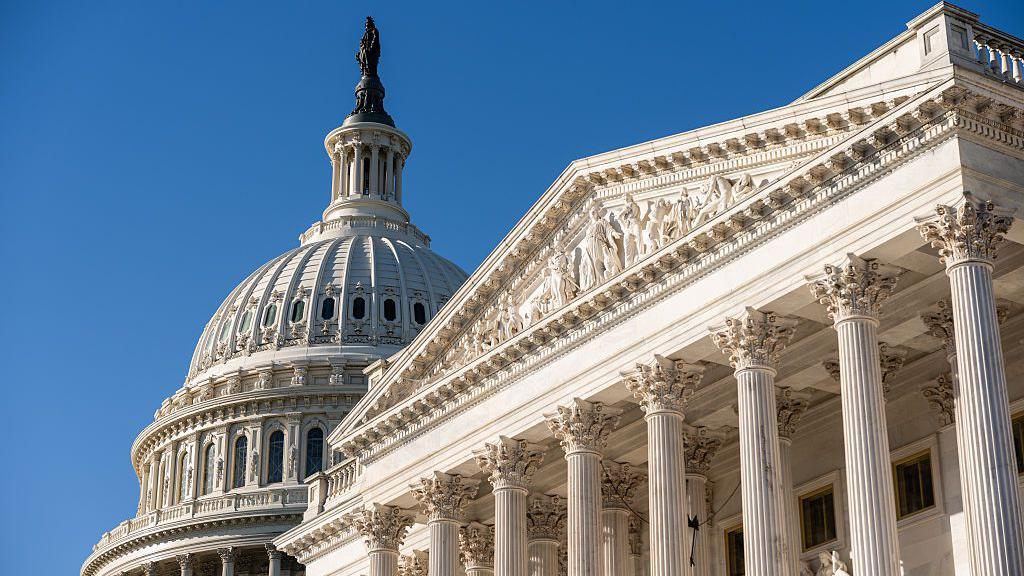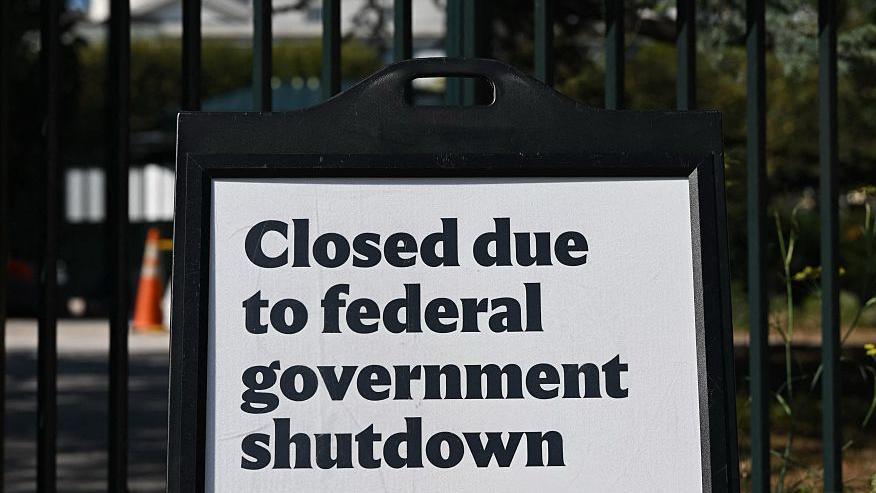Is the US government shutdown over, and why did it happen?

- Published
The longest-ever US government shutdown has ended after 43 days.
The fallout forced around 1.4 million federal employees to go without pay for weeks, suspended food to many low-income Americans and delayed or cancelled thousands of flights for airline passengers.
Here we unpack your key questions about the historic US funding deadlock.
Is the shutdown over?
Yes, it is.
The Republican-controlled House on Wednesday - day 43 of the shutdown - approved a new funding bill with a vote of 222 to 209. Six Democrats joined Republicans to vote yes.
The package passed the Senate two days earlier by a vote of 60-40, after seven Democrats and one independent senator sided with Republicans to approve it.
President Donald Trump signed it into law within hours, declaring, "It's a great day".
But it may still take a few days, or even weeks, to fully reopen the government and restart some vital programmes.
And with the busy Thanksgiving holiday period looming at the end of the month, it could take a while for airlines to fully recover from the disruption. Aviation capacity is growing as reductions imposed during the shutdown have tapered from 6% to 3%.
The busiest airports in the country had to cancel flights and reduce operations to cope with absences from unpaid air traffic controllers calling in sick.
What's in the funding package?
The 328-page bill extends money for most federal agencies until 30 January.
It provides funding for Snap food aid, as well as the Department of Agriculture, Congress and veterans affairs until September next year.
It guarantees that all federal workers will receive back-pay, and reverses the shutdown-related layoffs of thousands of federal workers.
The bill does not explicitly include what Democrats most wanted in this shutdown fight: a guaranteed extension of expiring health insurance subsidies that affect around 24 million Americans.
Instead of including the extension in the continuing resolution bill itself, senators made a deal to hold another vote on the tax credits at the end of the second week in December.
Healthcare costs are poised to skyrocket for lower income Americans if the subsidies are not renewed.
Democrats left bruised after historic shutdown yields little
- Published13 November
Democratic divisions and other takeaways from US shutdown deal
- Published10 November
The Democrats who backed Republican shutdown deal - and why
- Published10 November
The bill includes a number of other provisions, too.
It contains language that makes it illegal for federal prosecutors to search senators' phone records without notice, and allows for payouts of up to $500,000 for each violation.
The law is retroactive to 2022, meaning that it will allow several Republican senators to sue after their communications were searched as part of a probe into Trump's role in the Capitol Hill riot in January 2021.
The spending bill also reverses the legalisation of cannabis-derived hemp, which passed in 2018 as part of a larger farming bill. Its passage allowed the creation of a multi-billion dollar industry of low dosage THC products in the US, including edibles and drinks.
The new bill provision "prevents the unregulated sale of intoxicating hemp-based or hemp-derived products, including Delta-8, from being sold online, in gas stations, and corner stores, while preserving non-intoxicating CBD and industrial hemp products," according to a summary provided by the Senate.
Among its other provisions, the bill bans the Pentagon from increasing spending that was not specifically authorised previously. It also allocates $88m to increase security for Congress, the Supreme Court and the federal court system, due to increased threats of political violence.
Why did the US government shut down?
In the US system, both chambers of Congress must approve a spending plan to send to the president to be signed into law.
The House was able to pass a temporary funding bill to avoid a shutdown, but it could not clear the Senate amid Democratic resistance.
The Republicans currently control both the House of Representatives and the Senate, but at the end of September, senators were seven short of the 60 votes needed to pass a spending bill.
Republicans hold 53 seats in the chamber and needed Democrats to join them in the vote, giving liberals some negotiating leverage.
The party's main demand was that the bill should include an extension of expiring tax credits that make health insurance cheaper for millions of Americans.
So on 1 October, the US government shut down for the first time in nearly seven years.
"Government, just do your job" - Frustration at airports as shutdown delays continue
Which government services stopped, and when will they resume?
Thousands of government employees deemed non-essential were furloughed - temporarily put on unpaid leave. Most will be expected to return to work now.
During the shutdown, air traffic controllers were also expected to work without pay. But some of them had called in sick, leading to many flights being cancelled or delayed. The federal government even mandated flight cuts to airlines at 40 airports - including the nation's busiest - to help alleviate overworked air traffic controllers and others who had been working without pay.
Those workers will expect to see backpay within days of the government being reopened. The president has also suggested that air traffic controllers who worked through the shutdown could receive bonus pay too, although he has said he's unsure from where that money will come.
The Department of Homeland Security has begun issuing $10,000 bonus cheques to Transportation Security Administration agents who worked without pay and "with exemplary service" during the shutdown.
It could take up to a week for air travel to return to pre-shutdown capacity, the trade association for major US airlines has said.
But the situation will at least partially start to improve after the Federal Aviation Administration announced on 14 November that it will start loosening flight restrictions.
The FAA said that it will be inreasing air traffic capacity from 94% to 97%, starting on 15 November. The agency will monitor the system through the weekend and then decide when to return to 100% capacity.
More than 42 million Americans who rely on Snap food aid benefits have received only partial payments after the Supreme Court allowed the Trump administration to withhold some funding pending further legal hearings. Those funds will now go back to normal as the government reopens.
Museums and some monuments, such as the National Museum of American History and the National Air and Space Museum in Washington DC, which had closed their doors to visitors during the shutdown, began to reopen on 14 November. Others, such as the National Zoo, will reopen 15 November or on a rolling basis.
While most federal employees are not paid during a shutdown, members of Congress do continue to receive their salary.
Some federal programmes will take longer to rebound.
Liheap, a heating subsidy programme used by around 6 million low income households, won't be available for weeks, coming just as the winter months are arriving. Head Start, an early childhood education programme, also could take weeks to resume.
Not all areas of the government are impacted by a shutdown.
Federal law enforcement operated as usual, Social Security and Medicare cheques were still distributed, and mail delivered. The Trump administration also tapped into research funds and accepted money from an anonymous donor to pay military troops.
Five ways US government shutdown is hurting
- Published30 October

How has the shutdown affected the economy?
The impact of government shutdowns on the economy is typically limited and temporary - similar to the disruption caused by a hurricane or major storm.
But it still causes problems. Approvals for loans and permits are delayed and hundreds of millions of dollars in federal contracts are suspended.
Unlike government employees, contractors do not receive back pay once a shutdown ends, and many of them are small businesses without other big clients.
Overall, analysts had estimated that this shutdown would knock roughly 0.1 to 0.2 percentage points off economic growth for each week that it goes on - about $15bn a week.
What happened during previous US government shutdowns?
Shutdowns over budgets are a unique aspect of US politics.
The second-longest ever shutdown dragged on for 34 days, beginning in late 2018 during Trump's first presidential term.
But these legislative standoffs also predate the current president.
There were eight shutdowns during the presidency of Ronald Reagan in the 1980s, though all were relatively brief.
Former Democrat President Bill Clinton had a 21-day shutdown in 1995, while his fellow Democrat Barack Obama had a 16-day shutdown in 2013.
Do you have questions about the US government shutdown? Or are you a federal worker affected by the current situation? Get in touch via this form or by emailing bbcyourvoice@bbc.co.uk
Get in touch
Are you a US federal worker affected by the current situation? Or do you have questions about what's happening?